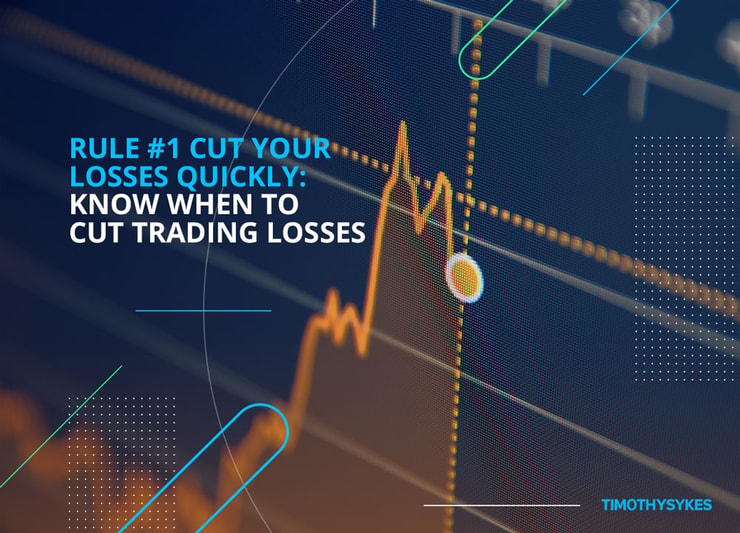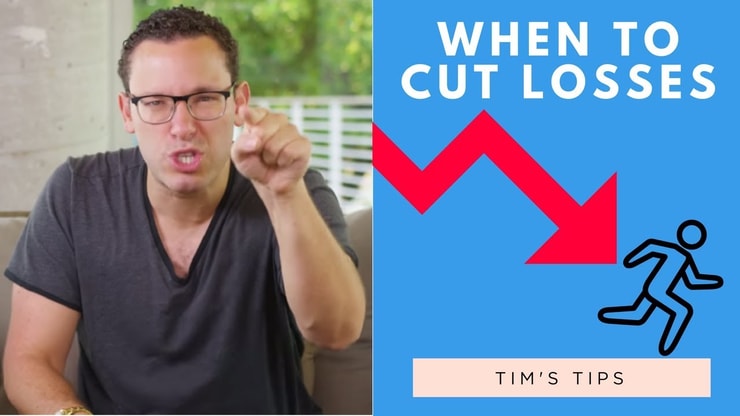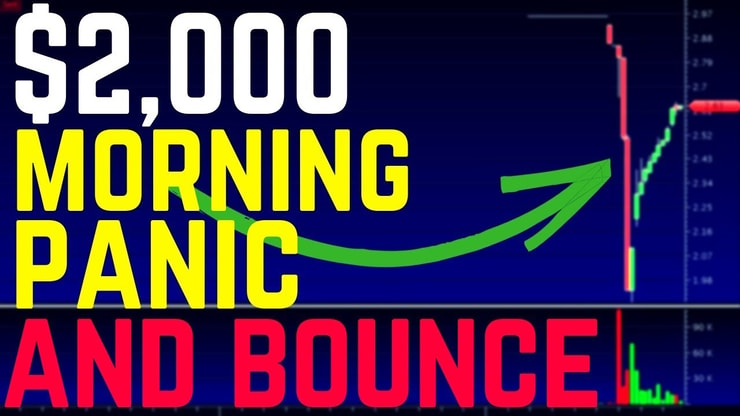I’m addressing a major topic today, gang …
It’s a really big deal: learning to cut your losses quickly. You must learn how to do this.
If you don’t know how to do it, just ONE mistake could seriously damage your confidence — not to mention the balance of your trading account.
And since every trade won’t be a winner, you need to be prepared for this right from the start.
For that reason, I prepared this post and the video below: to show you exactly how I cut losses on my trades and show you some examples.
After 20+ years trading stocks, I’ve found this is truly one of the most important things you need to know about trading, so I hope you can learn from me here.
I want you to know that this video is MANDATORY for all of my Trading Challenge students, so make sure you watch it and read the rest of this post for tips that can help you build the foundation of your trading career.
Also, for all my awesome, hearing-impaired Trading Challenge students, you’ll find everything below in the written post, so follow along with me …
Table of Contents
- 1 What Is the Meaning of “Cut Your Losses Quickly”?
- 2 Key Tips on How to Cut Your Losses Quickly
- 3 The Bottom Line
What Is the Meaning of “Cut Your Losses Quickly”?
A lot of people ask me, “Tim, what does it mean to cut stock losses? How do you know when to exit a trade?”
Both questions are very important and point back to my number-one rule in stock trading …
My answer: “I cut stock losses quickly. Period.” I live and die by this rule.
But what are the reasons behind it?
Well, first and foremost, let’s look at the origin of cutting your losses. It traces back to the foundation of any good trading plan: Exit a losing position before things can get worse. It’s a way to control your losses when things don’t go the way you’ve planned them.
There are also other factors I consider to determine exactly when to exit a trade, like the timing and the pattern behavior. But overall, I cut my losses quickly — and you’ll soon see why.
Why ‘Cut Your Losses Quickly’ Is My First Rule
Cutting losses quickly is of paramount importance because I want to keep trading with confidence and protect my trading capital.
I don’t want small mistakes to turn into a bigger disaster for whatever reason. I’m not interested in taking that risk!
I’ve seen newbies freeze in panic, losing more money by the minute, without knowing exactly what to do. And a big loss doesn’t just wreck your confidence, but it can also take a serious chunk out of your account.
Education is key in helping you here. I’ve learned these trading patterns inside and out and know their behavior very well. If a stock doesn’t do what I think, I’m out, and sometimes just for small gains.
My motto: Trade scared and cut losses fast. When in doubt, get out!
Trade scared? Yes! As wonky as that might sound, it can ultimately help you. You see, for me, trading scared actually makes me NOT scared to trade — instead, it helps me stay calm and ready to take the potential rewards on my next position.
Now let’s talk about how it can help you …
When to Cut Stock Losses?
When you take a trading position with a solid plan, you have a more vivid picture of what the stock might do.
So if you’re following a pattern that’s not working, the best thing you can do is exit your position.
Many times a pattern will turn against you and you’ll have to take a loss — but you don’t have to wait for a trade to become a loss to exit it.
As I mentioned, I even get out for small gains. There’s no shame in small gains; it beats a loss any day! If a pattern isn’t working for you, I strongly encourage you to get out with small- or medium-size gains too,
I want to give stocks as long as they can, but at the same time, if the stock isn’t doing what I want, I cut it. This helps keep me in control.
For example, if I’m buying a stock for a morning spike — let’s say it’s a crypto stock — and they just announced some new crypto company, theoretically, it should be spiking right away because that’s the hottest pattern right now …
But what if it doesn’t spike or if it stops spiking? I’m out. No matter if it’s already up 20% and I’m buying it, I’m out. I don’t care if I make five cents or lose five cents per share. I don’t care if I make $100 or lose $200. If the stock doesn’t do what I want, I’m out. Period.
Or let’s say I’m shorting a stock and it’s the first red day. I’m expecting a morning panic the next day, and there’s no panic. And say the company issued a press release overnight to try to pump themselves up and squeeze shorts and the stock starts going up …
What do I do? I’m out. I cut losses quickly. For me, it’s not just about the gain or the loss — it’s about following my plan and being consistent with my execution. This builds my confidence and strengthens my mindset; just more great reasons why I cut losses quickly.
In any case, you’ve gotta know the patterns. That’s why I always tell you to study hard, recognize all these patterns, learn from my 5,000+ video lessons, etc.
If you keep studying and dedicate yourself to this, you can potentially become an expert at these patterns just like I am.
And once you become an expert, you don’t have to wait for a trade to become a loss to exit it … you’ll know exactly what to do.
Key Tips on How to Cut Your Losses Quickly

2025 Millionaire Media, LLCNow, I’ll share some tips — or even better, some universal rules of trading stocks — that you should always follow when entering a position.
More Breaking News
- SaverOne: The Latest Updates and Market Trends
- CRISPR Therapeutics Reports Landmark Advances in Cardiovascular Trials
- AI Healthcare Surge Drives SoundHound AI Growth
#1 Control Your Emotions
Keeping your emotions in check is probably the hardest part of trading. This is a mental game.
And controlling your emotions applies not only when you’re executing a specific trade, but all the time — especially when you have to deal with a losing streak and need to turn your losses around.
You must develop a mindset where you assume that losses are a part of your journey, and you learn from them to get stronger.
The best traders I know master their emotions first, so they can come to the market every time with the right mindset.
The first step toward keeping your emotions under control is to come to every trade well prepared with a solid plan, knowing full well that a loss could happen. It’s something expected.
Heck, I only win roughly 70% of the time, so I learn from the 30% of my losing trades.**
Remember that this is a marathon, not a sprint — and during the course of the marathon, there WILL be setbacks. There will be failures, and you have to learn to deal with them to overcome them.
But guess what? They’ll help you in the long run. They’ll mold you. They’ll play a big role in developing your character as a successful trader.
#2 Don’t Trade Too Big
Another important rule: Never invest more than you can afford to lose.
You need to protect your capital. So only trade with amounts that you truly feel comfortable with.
If you can’t afford to take a loss on your trade, don’t make it in the first place! This is one of the 10 most important trading rules every stock trader must live by.
When a trade goes wrong and hits you more than you can afford, it slams your confidence, and you won’t be able to take advantage of the next truly hot stock that comes your way — so play it safe.
Your goal is to continue trading over the long term, so protect your account.
#3 Don’t Chase Your Losses
I plan my trades ahead of time, considering each risk/reward ratio and keeping every single trade on a very tight leash. I insist on limiting my risk in every trade.
But what do you do when the trade goes against you and can go beyond your risk?
My answer probably won’t shock you: You must be ready to cut your losses immediately.
I’m always prepared for things going wrong. No exceptions. You must always consider the possibility of being wrong; that’s part of the game.
Don’t get all ‘deer in headlights’ if the trade goes against you — just have a plan and stick to it.
Yes, it’s really that simple!
Sometimes, trades will run against you a bit and that doesn’t mean you have to cut them immediately. You might want to give it a bit more time, but that’s only if the trade is within the range of your plan.
But if the stock goes out of your planned risk zone, that means it has hit your stop (mental or otherwise), and it’s time to kick it to the curb immediately.
Don’t chase losses, OK? Don’t be in a position where you have to chase your losses while simultaneously being completely baffled about what to do. It’s a horrible position to be in and I don’t want it to happen to you. Just cut losses quickly. Boom. Done.
Have I mentioned “cut losses quickly” enough? Just checking.
#4 Don’t Let a Small Mistake Turning Into a Big Disaster

2025 Millionaire Media, LLCWhen you don’t follow your plan, what could have been a small and expected trading loss can become a large loss. Don’t fall into this pit!
I know waaaay too many traders that lose much more money than they expected because they don’t cut losses quickly and instead they say “Oh, I’m down just a little bit. Let me double up my position and reduce my average cost …”
That way they can get back in the game, right? Sometimes they double up, triple up, and even quadruple their position size if the stock is going against them — just because they’re trying to get back to smaller losses!
That might work a few times to escape breakeven … but more often than not, they have to take a much bigger loss.
Sometimes they even say “Tim, I told you I couldn’t cut losses quickly and I still came back.”
But guess what? They learned the wrong lesson. Yet they still keep doing it over and over and over again. And eventually, they get burned. It always happens.
Don’t be stubborn like that. It won’t help you!
Successful traders aren’t stubborn — we stick to our plans and risk levels we laid out ahead of time.
That is so, so, so KEY.
#5 Adjust Your Position Size
You can modulate your position size in every trade. Sometimes you can be more aggressive. Other times you need to be more conservative.
This isn’t just like going to the casino, where you’re betting on black or red and you double your money or lose all your money. You can modulate based on the situation.
For example, maybe a pattern has been working so well lately that you say “Why don’t I take a 50% larger position this time? Maybe I’ll double down.”
Or perhaps you’re buying an earnings winner, which in years past has been fantastic, but now, after a roughly a decade-long bull market, the earnings winners aren’t doing so well. You could enter the trade but take a half-size position.
See what I mean? You can adapt depending on the situation.
Sometimes, for example, you simply enter a trade with your regular position size and the stock is doing exactly what you want, but you have a meeting or a class or whatever. You might have to take profits earlier because of your own personal schedule.
See? You can adjust your position and manage your risk based on every unique situation.
#6 Master Your Chart-Pattern Knowledge
If you want to become a successful trader you’ve got to become a lifelong dedicated student, and mastering chart patterns is something you’ll probably spend a LOT of time on (especially if you’re into penny stocks like me and my Trading Challenge students).
For me, much of being a successful trader is about trading the right patterns. This knowledge has served me well and I want the same for you.**
Once you know the patterns inside and out, you’ll know when a pattern isn’t working well and the right time to get out. That’s why you should dive into learning about patterns from my massive vault of thousands of video lessons. In fact, you can start here with free lessons now.
From all the chart patterns you could trade, there are two that are the most important. I’ll share those with you now …
Morning Panics
The morning panic dip buy is one of the most solid patterns you can learn, and it works especially well for those with small accounts.
In this chart pattern, what you’re looking for is a penny stock that has risen dramatically over the past one, two, three weeks, and one that has automatically dropped in price — not on any bad news, but due to a regular price pullback that triggers a tsunami of stop-loss orders that causes the accelerated drop in price.
When this happens, my goal is to dip buy the stock to hopefully capture gains of 20%, 30% or even 50% within an hour or less, as the bounce is very potent and happens fast.
I loooove morning panics. I have more than 550 video lessons that address this pattern. Here’s one of them …
Supernova
Know what else I love? The supernova. Fun fact: Supernovas are—above and beyond—my favorite chart pattern to play.
It’s basically an explosion in stock price that creates many opportunities to buy on the way up and short sell the stock on the way down.
Most of the time, there’s not much financial information available with these, but you start noticing a gradual increase in price over the weeks, then the momentum continues until the price explodes exponentially and creates the opportunity.
And if that opportunity is there, you don’t want to miss it — so learn this pattern well!
#7 Learn The Sykes Sliding Scale
Many people ask me, “Tim, How do you pick your trades?
From the vast universe of patterns, stocks and potential opportunities, which ones are the best?
I have strong selection criteria to filter every trade and a trade-ranking system that allows me to filter the real gems from the noise.
I call this ranking system the Sykes Sliding Scale (SSS) and it’s based in the ranking of seven factors I grouped under the acronym PREPARE.
Here’s what each letter stands for …
P: Pattern/ Price
R: Risk/Reward Ratio
E: Base of Entry/Exit
P: Past performance/History of spiking big.
A: At what time of day is it? What’s your personal schedule?
R: Reason/Catalyst
E: Market Environment
From these seven factors, the three most important are:
- P: Pattern/Price
- R: Risk/Reward Ratio
- A: At what time of day is it?/Personal Schedule.
Combined, they count for 60% of the scale. And there are good reasons for that, but you’ll have to dig deeper because I’ve gotta wrap up this post shortly, so make sure you check out some of my other free material where I explain the SSS in more detail.
#8 Knowledge Supports Growth

2025 Millionaire Media, LLCSince you know that you’ll have losses, use them to your advantage: Make your losses your own teacher.
Think of losses as partial tuition you pay toward your trading education. Keep a record of them in your trading journal and study what went wrong in every case.
- Was it the execution of the trade?
- Did you choose the wrong pattern?
- Did you take too much risk this time?
- Why didn’t the pattern work as expected?
Keep track of this information, and you’ll learn a lot every time. Soon, you’ll begin to understand what trading moves are working for you — and those that are holding you back.
Another smart move: Learning from others.
If you’re interested in learning from people who have been in the hardcore trading trenches — me as well as my top students — consider joining my Trading Challenge. It’s the ultimate way to communicate with other traders, get tips, share your plays, and learn from others’ successes and failures.
You’ll get access to tons of resources, including my every trade, so you can learn how to make trades for yourself. It’s also a great way to hold yourself accountable to your goals and to keep your ego in check.
When you go it alone, you risk making small-but-critical mistakes that deplete your profits.
Join us today and start learning from the experts. You won’t find promoters or other scam artists. It’s just a community of people who want to change their lives with the stock market.
The Bottom Line

2025 Millionaire Media, LLCAs you’ve learned here, losses will unquestionably be a part of your trading career, so the faster you get used to dealing with and learning from them, the faster you can progress as a trader.
Remember that you always need to:
- Plan out and fully prepare for every trade
- Stick to your plan
- And cut your losses quickly if/when you realize the pattern isn’t working
Limit your trades to those with a good risk/reward ratio based on the pattern — they’re the ones that can help keep your losses on a short leash while having a big reward potential. Be selective in every case!
And again, turn every loss into a source of wisdom. It will make you a stronger, wiser, and more confident trader. In this game, the right mindset is everything, so do everything you can to increase your chance of becoming a better trader.
Which of these helps YOU best cope with your trading losses: your mental/emotional state or your technical knowledge? Why? Share your comments below.












Leave a reply